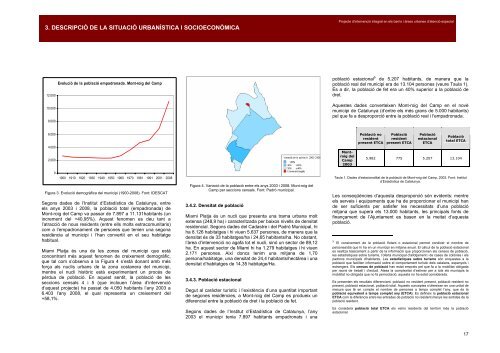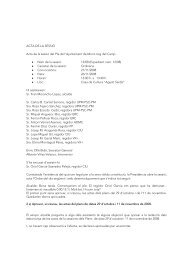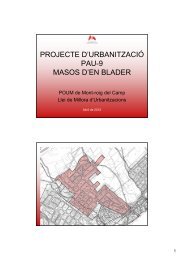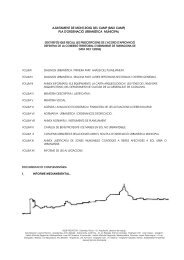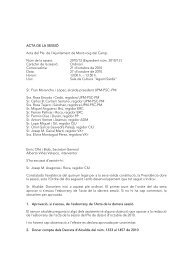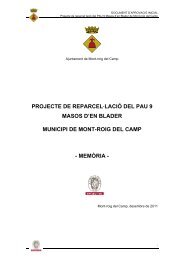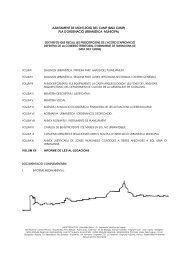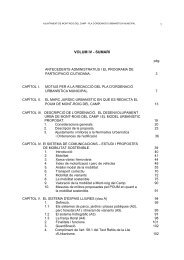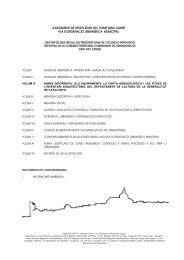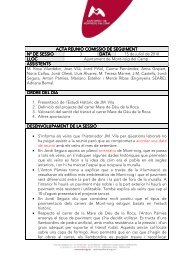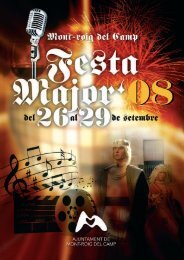Coneix el projecte - Ajuntament de Mont-roig del Camp
Coneix el projecte - Ajuntament de Mont-roig del Camp
Coneix el projecte - Ajuntament de Mont-roig del Camp
Create successful ePaper yourself
Turn your PDF publications into a flip-book with our unique Google optimized e-Paper software.
3. DESCRIPCIÓ DE LA SITUACIÓ URBANÍSTICA I SOCIOECONÒMICA<br />
12.000<br />
10.000<br />
8.000<br />
6.000<br />
4.000<br />
2.000<br />
0<br />
Evolució <strong>de</strong> la població empadronada. <strong>Mont</strong>-<strong>roig</strong> d<strong>el</strong> <strong>Camp</strong><br />
1900 1910 1920 1930 1940 1950 1960 1970 1981 1991 2001 2008<br />
Figura 3. Evolució <strong>de</strong>mogràfica d<strong>el</strong> municipi (1900-2008). Font: IDESCAT<br />
Segons da<strong>de</strong>s <strong>de</strong> l’Institut d’Estadística <strong>de</strong> Catalunya, entre<br />
<strong>el</strong>s anys 2003 i 2008, la població total (empadronada) <strong>de</strong><br />
<strong>Mont</strong>-<strong>roig</strong> d<strong>el</strong> <strong>Camp</strong> va passar <strong>de</strong> 7.897 a 11.131habitants (un<br />
increment d<strong>el</strong> +40,95%). Aquest fenomen es <strong>de</strong>u tant a<br />
l’atracció <strong>de</strong> nous resi<strong>de</strong>nts (entre <strong>el</strong>ls molts extracomunitaris)<br />
com a l’empadronament <strong>de</strong> persones que tenien una segona<br />
residència al municipi i l’han convertit en <strong>el</strong> seu habitatge<br />
habitual.<br />
Miami Platja és una <strong>de</strong> les zones d<strong>el</strong> municipi que està<br />
concentrant més aquest fenomen <strong>de</strong> creixement <strong>de</strong>mogràfic,<br />
que tal com s’observa a la Figura 4 s’està donant amb més<br />
força als nuclis urbans <strong>de</strong> la zona costanera d<strong>el</strong> municipi,<br />
mentre <strong>el</strong> nucli històric està experimentant un procés <strong>de</strong><br />
pèrdua <strong>de</strong> població. En aquest sentit, la població <strong>de</strong> les<br />
seccions censals 4 i 5 (que inclouen l’àrea d’intervenció<br />
d’aquest <strong>projecte</strong>) ha passat <strong>de</strong> 4.050 habitants l’any 2003 a<br />
6.403 l’any 2008, <strong>el</strong> qual representa un creixement d<strong>el</strong><br />
+58,1%.<br />
Figura 4. Variació <strong>de</strong> la població entre <strong>el</strong>s anys 2003 i 2008. <strong>Mont</strong>-<strong>roig</strong> d<strong>el</strong><br />
<strong>Camp</strong> per seccions censals. Font: Padró municipal.<br />
3.4.2. Densitat <strong>de</strong> població<br />
Miami Platja és un nucli que presenta una trama urbana molt<br />
extensa (248,9 ha) i caracteritzada per baixos niv<strong>el</strong>ls <strong>de</strong> <strong>de</strong>nsitat<br />
resi<strong>de</strong>ncial. Segons da<strong>de</strong>s d<strong>el</strong> Cadastre i d<strong>el</strong> Padró Municipal, hi<br />
ha 8.126 habitatges i hi viuen 5.637 persones, <strong>de</strong> manera que la<br />
<strong>de</strong>nsitat és <strong>de</strong> 33 habitatges/ha i 24,65 habitants/ha. No obstant,<br />
l’àrea d’intervenció no agafa tot <strong>el</strong> nucli, sinó un sector <strong>de</strong> 89,12<br />
ha. En aquest sector <strong>de</strong> Miami hi ha 1.279 habitatges i hi viuen<br />
2.171 persones. Així doncs tenim una mitjana <strong>de</strong> 1,70<br />
persona/habitatge, una <strong>de</strong>nsitat <strong>de</strong> 24,4 habitants/hectàrea i una<br />
<strong>de</strong>nsitat d’habitatges <strong>de</strong> 14,35 habitatge/Ha.<br />
3.4.3. Població estacional<br />
Degut al caràcter turístic i l’existència d’una quantitat important<br />
<strong>de</strong> segones residències, a <strong>Mont</strong>-<strong>roig</strong> d<strong>el</strong> <strong>Camp</strong> es produeix un<br />
diferencial entre la població <strong>de</strong> dret i la població <strong>de</strong> fet.<br />
Segons da<strong>de</strong>s <strong>de</strong> l’Institut d’Estadística <strong>de</strong> Catalunya, l’any<br />
2003 <strong>el</strong> municipi tenia 7.897 habitants empadronats i una<br />
Projecte d’intervenció integral en <strong>el</strong>s barris i àrees urbanes d’atenció especial<br />
població estacional 5 <strong>de</strong> 5.207 habitants, <strong>de</strong> manera que la<br />
població real d<strong>el</strong> municipi era <strong>de</strong> 13.104 persones (veure Taula 1).<br />
És a dir, la població <strong>de</strong> fet era un 40% superior a la població <strong>de</strong><br />
dret.<br />
Aquestes da<strong>de</strong>s converteixen <strong>Mont</strong>-<strong>roig</strong> d<strong>el</strong> <strong>Camp</strong> en <strong>el</strong> novè<br />
municipi <strong>de</strong> Catalunya (d’entre <strong>el</strong>s més grans <strong>de</strong> 5.000 habitants)<br />
p<strong>el</strong> que fa a <strong>de</strong>sproporció entre la població real i l'empadronada.<br />
<strong>Mont</strong><strong>roig</strong><br />
d<strong>el</strong><br />
<strong>Camp</strong><br />
2003<br />
Població no<br />
resi<strong>de</strong>nt<br />
present ETCA<br />
Població<br />
resi<strong>de</strong>nt<br />
present ETCA<br />
Població<br />
estacional<br />
ETCA<br />
Població<br />
total ETCA<br />
5.982 775 5.207 13.104<br />
Taula 1. Da<strong>de</strong>s d’estacionalitat <strong>de</strong> la població <strong>de</strong> <strong>Mont</strong>-<strong>roig</strong> d<strong>el</strong> <strong>Camp</strong>, 2003. Font: Institut<br />
d’Estadística <strong>de</strong> Catalunya.<br />
Les conseqüències d’aquesta <strong>de</strong>sproporció són evi<strong>de</strong>nts: mentre<br />
<strong>el</strong>s serveis i equipaments que ha <strong>de</strong> proporcionar <strong>el</strong> municipi han<br />
<strong>de</strong> ser suficients per satisfer les necessitats d’una població<br />
mitjana que supera <strong>el</strong>s 13.000 habitants, les principals fonts <strong>de</strong><br />
finançament <strong>de</strong> l’<strong>Ajuntament</strong> es basen en la meitat d’aquesta<br />
població.<br />
5 El coneixement <strong>de</strong> la població flotant o estacional permet conèixer <strong>el</strong> nombre <strong>de</strong><br />
persones/dia que hi ha en un municipi en mitjana anual. El càlcul <strong>de</strong> la població estacional<br />
es realitza bàsicament a partir <strong>de</strong> la informació que proporcionen <strong>el</strong>s censos <strong>de</strong> població,<br />
les estadístiques sobre turisme, l’oferta municipal d’allotjament i <strong>de</strong> cases <strong>de</strong> colònies i <strong>el</strong>s<br />
padrons municipals d’habitants. Les estadístiques sobre turisme són enquestes a la<br />
població que faciliten informació sobre <strong>el</strong> comportament turístic d<strong>el</strong>s catalans, espanyols i<br />
estrangers. Els censos <strong>de</strong> població han estat emprats p<strong>el</strong> que fa a la mobilitat obligada<br />
per raons <strong>de</strong> treball i d’estudi. Atesa la complexitat d’estimar per a tots <strong>el</strong>s municipis la<br />
mobilitat no obligada que no fa pernoctació, aquesta no ha estat consi<strong>de</strong>rada.<br />
Es presenten <strong>el</strong>s resultats diferenciant: població no resi<strong>de</strong>nt present, població resi<strong>de</strong>nt no<br />
present, població estacional, població total. Aquests conceptes s’ofereixen en una unitat <strong>de</strong><br />
mesura que té en compte <strong>el</strong> nombre <strong>de</strong> persones a temps complet l’any, que és la<br />
població equivalent a temps complet any (ETCA). Es <strong>de</strong>fineix la població estacional<br />
ETCA com la diferència entre les entra<strong>de</strong>s <strong>de</strong> població no resi<strong>de</strong>nt menys les sorti<strong>de</strong>s <strong>de</strong> la<br />
població resi<strong>de</strong>nt.<br />
Es consi<strong>de</strong>ra població total ETCA <strong>el</strong>s veïns resi<strong>de</strong>nts d<strong>el</strong> territori més la població<br />
estacional.<br />
17


